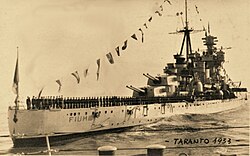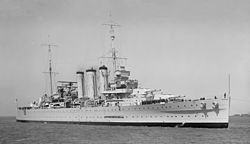Liste der Schweren Kreuzer
In der Liste der Schweren Kreuzer sind alle zwischen 1916 und 1949 gebauten und in Dienst gestellten Schweren Kreuzer aufgeführt.
Liste der Schiffe
Argentinien
- Veinticinco-de-Mayo-Klasse
- ARA Almirante Brown (C-1) (1929)
- ARA Veinticinco de Mayo (C-2) (1929)
- ARA Almirante Brown
- ARA Veinticinco de Mayo
Australien
- (Britische) County-Klasse
- HMAS Australia
- HMAS Canberra
Deutschland
- Admiral-Hipper-Klasse
- Admiral Hipper (1937)
- Blücher (1937)
- Prinz Eugen (1938)
- Seydlitz (1939) – nicht fertiggestellt
- Lützow (1939) – unfertig 1939 an die Sowjetunion verkauft
- Admiral Hipper
- Blücher
- Prinz Eugen
- Seydlitz
- Lützow
Frankreich
- Duquesne-Klasse
- Duquesne (1925)
- Tourville (1926)
- Suffren-Klasse
- Suffren (1927)
- Colbert (1928)
- Foch (1929)
- Dupleix (1930)
- Algérie (1932)
- Duquesne
- Tourville
- Suffren
- Colbert
- Foch
- Dupleix
- Algérie
Großbritannien
- Hawkins-Klasse
- HMS Hawkins (1917)
- HMS Cavendish (1918)
- HMS Raleigh (1919)
- HMS Frobisher (1920)
- HMS Effingham (1921)
- County-Klasse
- Kent-Gruppe
- HMS Kent (1926)
- HMS Suffolk (1926)
- HMS Cornwall (1926)
- HMS Cumberland (1926)
- HMS Berwick (1926)
- London-Gruppe
- HMS London (1927)
- HMS Devonshire (1927)
- HMS Sussex (1928)
- HMS Shropshire (1928)
- Norfolk-Gruppe
- HMS Norfolk (1928)
- HMS Dorsetshire (1929)
- Surrey-Gruppe – alle 1930 storniert
- HMS Surrey
- HMS Northumberland
- (ohne Namen)
- Kent-Gruppe
- York-Klasse
- HMS York (1928)
- HMS Exeter (1929)
- HMS Hawkins
- HMS Effingham
- Kreuzer der County-Klasse
- HMS Kent
- HMS Devonshire
- HMS Norfolk
- HMS York
- HMS Exeter
Italien
- Trento-Klasse
- Trento (1927)
- Trieste (1926)
- Zara-Klasse
- Zara (1930)
- Fiume (1930)
- Gorizia (1931)
- Pola (1932)
- Bolzano (1932)
- Trento
- Trieste
- Zara
- Fiume
- Gorizia
- Pola
- Bolzano
Japan
- Furutaka-Klasse
- Furutaka (1925)
- Kako (1925)
- Aoba-Klasse
- Aoba (1926)
- Kinugasa (1926)
- Myōkō-Klasse
- Takao
- Mogami-Klasse – mit der Bewaffnung leichter Kreuzer (15,5-cm-Geschütze) gebaut, 1939 zu schweren Kreuzern umarmiert (20,3-cm-Geschütze)
- Tone-Klasse
- Ibuki
- Ibuki (1942) – als Schwerer Kreuzer begonnen, ab November 1943 zum Flugzeugträger umgebaut, nicht fertiggestellt
- Nr. 301 (1942) – Bau 1942 abgebrochen
- Furutaka
- Aoba
- Myōkō
- Atago
- Mogami, noch als leichter Kreuzer bewaffnet
- Tone
- Ibuki
Sowjetunion
- Krasni Kawkas (1916) – als leichter Kreuzer Admiral Lasarew begonnen, 1926 umbenannt und 1932 als schwerer Kreuzer fertiggestellt
- Kirow-Klasse
- Erste Gruppe (Projekt 26)
- Kirow (1936)
- Woroschilow (1937)
- Zweite Gruppe (Projekt 26-bis)
- Maxim Gorki (1938)
- Molotow (1939)
- Dritte Gruppe (Projekt 26-bis2)
- Kaganowitsch (1944) – 1945 in Lasar Kaganowitsch, 1957 in Petropawlowsk umbenannt
- Kalinin (1942)
- Erste Gruppe (Projekt 26)
- Petropawlowsk – ex deutsche Lützow, 1939 angekauft; 1944 in Tallinn, 1949 in Dnepr umbenannt, nicht fertiggestellt
- Krasni Kawkas
- Woroschilow
- Molotow
- Kaganowitsch
- Tallinn
Spanien
- Canarias
- Canarias (1931)
- Baleares (1932)
- Canarias
Vereinigte Staaten
- Pensacola-Klasse
- USS Pensacola (CA-24) (1929)
- USS Salt Lake City (CA-25) (1929)
- Northampton-Klasse
- USS Northampton (CA-26) (1929)
- USS Chester (CA-27) (1929)
- USS Louisville (CA-28) (1930)
- USS Chicago (CA-29) (1930)
- USS Houston (CA-30) (1929)
- USS Augusta (CA-31) (1930)
- Portland-Klasse
- USS Portland (CA-33) (1932)
- USS Indianapolis (CA-35) (1931)
- New-Orleans-Klasse
- USS New Orleans (CA-32) (1933)
- USS Astoria (CA-34) (1933)
- USS Minneapolis (CA-36) (1933)
- USS Tuscaloosa (CA-37) (1933)
- USS San Francisco (CA-38) (1933)
- USS Quincy (CA-39) (1935)
- USS Vincennes (CA-44) (1936)
- USS Wichita (CA-45) (1937)
- Baltimore-Klasse
- USS Baltimore (CA-68) (1942)
- USS Boston (CA-69) (1942) – 1952/55 zum Lenkwaffenkreuzer umgebaut
- USS Canberra (CA-70) (1943) – 1952/56 zum Lenkwaffenkreuzer umgebaut
- USS Quincy (CA-71) (1943)
- USS Pittsburgh (CA-72) (1944)
- USS Saint Paul (CA-73) (1944)
- USS Columbus (CA-74) (1944) – 1959/62 zum Lenkwaffenkreuzer umgebaut
- USS Helena (CA-75) (1945)
- USS Bremerton (CA-130) (1944)
- USS Fall River (CA-131) (1944)
- USS Macon (CA-132) (1944)
- USS Toledo (CA-133) (1945)
- USS Los Angeles (CA-135) (1944)
- USS Chicago (CA-136) (1944) – 1958/64 zum Lenkwaffenkreuzer umgebaut
- Oregon-City-Klasse
- USS Oregon City (CA-122) (1945)
- USS Albany (CA-123) (1945) – 1958/62 zum Lenkwaffenkreuzer umgebaut
- USS Rochester (CA-124) (1945)
- USS Northampton (CA-125/CLC-1) (1951) – als Stabsschiff fertiggestellt
- USS Cambridge (CA-126) – Bau 1945 abgebrochen
- USS Bridgeport (CA-127) – Bau 1945 abgebrochen
- USS Kansas City (CA-128) – Bau 1945 abgebrochen
- USS Tulsa (CA-129) – 1945 storniert
- USS Norfolk (CA-137) – Bau 1945 abgebrochen
- USS Scranton (CA-138) – Bau 1945 abgebrochen
- Des-Moines
- USS Des Moines (CA-134) (1946)
- USS Salem (CA-139) (1947)
- USS Dallas (CA-140) – Bau 1946 abgebrochen
- CA-141 – 1946 storniert
- CA-142 und CA-143 – 1945 storniert
- USS Newport News (CA-148) (1948)
- CA-149 bis CA-153 – 1945 storniert
- USS Pensacola (CA-24)
- USS Louisville (CA-28)
- USS Indianapolis (CA-35)
- USS Quincy (CA-39)
- USS Wichita (CA-45)
- USS Canberra (CA-70)
- USS Canberra, zum Lenkwaffenkreuzer umgebaut
- USS Chicago (CA-136)
- USS Chicago, zum Lenkwaffenkreuzer umgebaut
- USS Rochester (CA-124)
- USS Northampton (CLC-1)
- USS Newport News (CA-148)
Siehe auch
- Schwerer Kreuzer
- Liste der Panzerkreuzer
- Liste der Geschützten Kreuzer
- Liste der Scoutkreuzer
- Liste der Leichten Kreuzer
Literatur
- Robert Gardiner, Randal Gray (Hrsg.): Conway’s All the World’s Fighting Ships 1906–1921. 3. Auflage. Conway Maritime Press, London 1997, ISBN 0-85177-245-5.
- Robert Gardiner, Roger Chesneau (Hrsg.): Conway’s All the World’s Fighting Ships 1922–1946. 2. Auflage. Conway Maritime Press, London 1987, ISBN 0-85177-146-7.
Auf dieser Seite verwendete Medien
The U.S. Navy heavy cruiser USS Wichita (CA-45) operating in the Atlantic Ocean, out of Norfolk, Virginia (USA), on 1 May 1940. Note the markings on her turret tops (bars on the forward turrets, a circle on the after turret). These scheme was used on several other heavy cruisers in 1939-40.
Heavy cruiser Furutaka off Nagasaki shortly after commisioning
HMS EFFINGHAM in Norway, 16 May 1940.
At anchor in a Norwegian Fjord.
The U.S. Navy heavy cruiser USS Canberra (CA-70) at sea, in October 1968. Note: Although RIM-2 Terrier missiles are visible aft, Canberra was redesignated from guided missile cruiser CAG-2 to heavy cruiser CA-70 on 1 May 1968, due to the obsolescence of her missile armament.
Autor/Urheber: Jose María Gonzalez, Lizenz: CC BY-SA 3.0
L'incrociatore pesante spagnolo Canarias ormeggiato ad Almeria
The U.S. Navy heavy cruiser USS Canberra (CA-70) underway off Boston, Massachusetts (USA), on 14 October 1943.
Olasz hadihajó.
Luftaufklärungsfoto der Royal Air Force vom 8. Mai 1942. Unten der noch nicht fertiggestellte schwere Kreuzer Seydlitz, daneben wahrscheinlich der am 5. Mai vom Stapel gelaufene Zerstörer Z 34. Die beiden Zerstörer am Kai rechts sind wahrscheinlich Z 32 (an der Kaimauer, mit Schornsteinen) und Z 33 (noch ohne Schornsteine).
The Royal Navy heavy cruiser HMS Norfolk (78) in Hampton Roads, Virginia (USA), on 29 September 1933.
ARA 25 de Mayo
Soviet cruiser Krasnyy Kavkaz.
The U.S. Navy heavy cruiser USS Pensacola (CA-24) underway at sea in September 1935.
The Italian cruiser Gorizia .
The French heavy cruiser Foch in the 1930s.
日本海軍航空母艦「伊吹」解体の為旧佐世保海軍工廠にて撮影された写真。
Ibuki, Imperial Japanese Navy aircraft carrier, under dismantling operation at Sasebo Factory, Japan. October, 1946Aerial view of the heavy cruiser HMS Hawkins
The U.S. Navy Baltimore-class heavy cruiser USS Chicago (CA-136) off the Philadelphia Naval Shipyard, Pennsylvania (USA), on 7 May 1945. Note Curtiss SC-1 Seahawk seaplanes on the catapults and her Measure 21 camouflage paint. Chicago was commissioned only for 1 1/2 years before joining the reserve fleet. She was converted to a guided missile cruiser from 1959 to 1964 and finally decommissioned in 1980.
(German Heavy Cruiser, 1939-1945) In Norwegian waters, during World War II. U.S. Naval History and Heritage Command Photograph.
The Soviet cruiser Tallinn at Leningrad, Soviet Union, in the late 1940s. Tallinn was built in Germany as the heavy cruiser Lützow. She was sold to the Soviet Union in 1940, but was never completed. The ship became a barracks ship in 1949 and was scrapped in 1960. / View from English (Krasnogo Flota) Embankment through Leutenant Shmidt Bridge to the Leutenant Shmidt Embankment. /
Zara on May 5, 1938
County-class cruiser
British 10,000 ton Cruisers
HMS Devonshire
The U.S. Navy heavy cruiser USS Newport News (CA-148) underway on 1 February 1960.
The U.S. Navy heavy cruiser USS Quincy (CA-39) in New York harbour, following her last overhaul. In the left background is the British escort carrier HMS Biter (D97). Note Quincy´s Modified Measure 12 camouflage scheme.
Autor/Urheber: A. Bernini, Lizenz: CC BY-SA 3.0
Regia Nave Fiume (Taranto, 1933).
The Royal Australian Navy heavy cruiser HMAS Canberra (D33) leaving Wellington, New Zealand, on 22 July 1942. She was en route to participate in the invasion of Guadalcanal and Tulagi.
The Royal Navy during the Second World War
HMS KENT underway off Liverpool.
The Royal Navy heavy cruiser HMS Exeter (68), in the 1930s.
Autor/Urheber: Riksarkivet (National Archives of Norway) from Oslo, Norway, Lizenz: No restrictions
The cruiser Blücher (launched 1937), the lead ship of the German armada headed for Oslo, Norway, was sunk in the Oslofjord by Norwegian military at Oscarsborg Fortress during the Battle of Drøbak Sound on 9 April 1940, the first day of the German invasion of Norway (part of the Norwegian Campaign in World War II). By sinking the ship the Norwegian king and government were saved from being taken captive in the first hours of the invasion. The number of casualties is unknown, but the loss of life probably ranges between 600 and 1,000 soldiers and sailors. The wreck remains on the bottom of the Oslofjord. Photo from Flickr album "Sjøfart i krig" by Riksarkivet (National Archives of Norway)
The French heavy cruiser Suffren in Hampton Roads, Virginia (USA), to attend the sesqui-centennial of the Battle of Yorktown, on 15 October 1931.
Japanese heavy cruiser Tone in early 1942. Photo was taken from battleship Hiei.
First argentine heavy cruiser ARA Almirante Brown (C-1)
Der schwere Kreuzer Prinz Eugen ankert im Atomtestgebiet beim Bikini-Atoll.
The Italian cruiser Bolzano , before World War II.
Imperial Japanese Navy heavy cruiser Aoba undergoing sea trials on July 23, 1927.
The U.S. Navy guided missile cruiser USS Chicago (CG-11) underway in the early 1970s.
The U.S. Navy heavy cruiser USS Indianapolis (CA-35) underway at sea on 27 September 1939.
Japanese cruiser Mogami after the comission, july 1935.
The Algérie entered the shelter harbor, at Brest, on the evening of May 27, 1937, after the offshore naval review with the Dunkerque.
The U.S. Navy heavy cruiser USS Rochester (CA-124) underway in San Francisco Bay, California (USA), at the time of Fleet Admiral Chester W. Nimitz' review of the First Fleet, 13 June 1957.
The French heavy cruiser Duquesne in 1943, probably during her voyage from Alexandria, Egypt, to Dakar, French West Africa, in July and August 1943 (via the Indian Ocean).
The U.S. Navy command ship USS Northampton (CLC-1) underway, circa 1959. She carries a variety of radars (front to back): SPS-10, a modified SK-2, SPS-2, SPS-29, and SPS-8A.
The U.S. Navy heavy cruiser USS Louisville (CA-28) visiting Australia, 2 February 1938.
The Soviet cruiser Molotov.
Japanese heavy cruiser Atago on full-power trials. Sukumo Bay, 13 February 1932.
HMAS Australia
The Italian cruiser Trento, photographed early in her career at Venice, Italy.











































































































